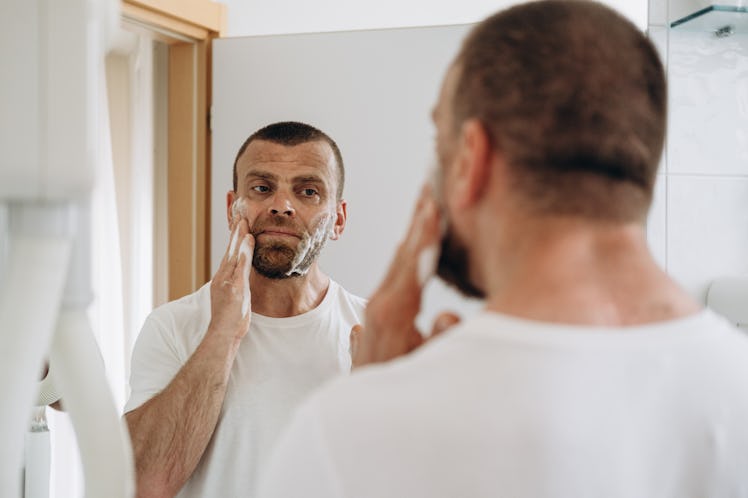Minoxidil Helps Balding Men — But Does It Work For Beard Growth?
How to beat a patchy beard.

Who doesn’t love a beard? Whether it’s short and neatly-groomed a la Drake, or the wild, anything-goes variety Jason Momoa proudly rocks, the beard is a grooming mainstay that looks great on any guy. But not all men can grow one — naturally, at least. Scroll through TikTok long enough, and you’ll find men claiming that one medication helped them transform their previously scraggly facial hair into a thick, full beard: minoxidil, the active ingredient in Rogaine.
So does minoxidil actually work for beard growth? And is it safe? Here’s what the science says.
What Is Minoxidil?
Minoxidil evolved in a kind of happy accident. This drug is a vasodilator, meaning it expands blood vessels. Originally, it was invented to treat high blood pressure. But soon after minoxidil’s approval, doctors noticed a strange side effect in some patients: Men who were balding were suddenly growing full heads of hair. In response, scientists developed a topical formulation of the drug that people could slather right on their heads. (Today, minoxidil is rarely prescribed for high blood pressure due to side effects associated with the old formulation, which was given as a pill.)
There isn’t much research out there on why minoxidil encourages hair growth. One hypothesis: It allows more blood to reach hair follicles, bulbs in the skin which produce hair. Hair follicles do their job in four stages: anagen, catagen, telogen, and exogen. During the anagen phase, which can last months (for facial hair) to years (for the hair on your head), follicles push out hairs by stacking cells on top of one another. In the catagen phase, the hair stops growing and becomes unstuck from the bottom of the follicle. In the telogen phase, a new hair starts growing beneath the old one. Finally, in the exogen phase, the follicle sheds the old hair. The extra blood flow from minoxidil seems to change the timing of hair growth.
In a 1990 study published in the Journal of Dermatology, scientists studied rats treated with minoxidil and compared them to rats that received no medication. They found that minoxidil shortened the telogen phase from 20 days in untreated rats to between one and two days in treated rats. In other words, the drug seemed to speed the growth of new hairs.
How Minoxidil Works for Facial Hair
So minoxidil works for balding. But can it help you grow facial hair? There isn’t much research out there to answer this question — minoxidil has mainly been studied in male-pattern baldness. It’s also important to note that minoxidil isn’t approved by the FDA for facial hair growth.
That said, one 2016 study published in the Journal of Dermatology does suggest that minoxidil could be a safe and effective way to encourage a fuller-looking beard. Scientists recruited 48 men and randomly gave them either minoxidil or a placebo cream — the men didn’t know what they were getting. The men applied the solution to their face two times daily for 16 weeks. At the end of the study, doctors analyzed photos of each of the men. Without knowing which solution they had received, the researchers rated the fullness of each man’s beard. Meanwhile, the men also were asked to rate their own beards. Both sets of ratings were higher, on average, for men who had received minoxidil compared to those who didn’t. Additionally, the scientists counted hairs in a particular patch of skin under the mens’ noses. Those who received minoxidil saw their facial hairs grow more dense over time, while hair density didn’t change for men who got the placebo.
If you do use minoxidil on your face, however, be on the lookout for side effects. You might experience itching, skin irritation, acne, soreness, red skin, or swelling, according to the Mayo Clinic. Signs that your body is absorbing too much medication include blurred vision, chest pain, dizziness, and lightheadedness. If these latter side effects do appear, stop taking minoxidil immediately and contact your doctor.
Where Should You Start?
Minoxidil typically comes in two forms: a foam or a liquid. There doesn’t appear to be a difference in effectiveness between the two, according to an article published in the Indian Journal of Dermatology. That said, if you’re prone to skin irritation, the liquid option might be a better choice, according to Hims, a telehealth company for men. That’s because foam contains propylene glycol, which can irritate sensitive skin.
Adding a minoxidil product to your daily routine takes only seconds. After washing your face, apply your minoxidil-containing product to damp beard skin. Not wet, just damp, as products tend to penetrate better into damp skin. Gently massage it in, focusing on the areas in which you want thicker, denser hair. Once it’s in, wash your hands and continue with the rest of your skincare, being careful not to spread the product onto the rest of your face.
When using minoxidil to thicken your beard, the last step in your daily routine should be patience. If it works for you, it may take several months before you see any new growth, according to the Mayo Clinic. Once you do, don’t stop! (Unless you’re experiencing side effects or done with your new beard, that is.) The effects of minoxidil only last as long as you’re applying it.
This article was originally published on